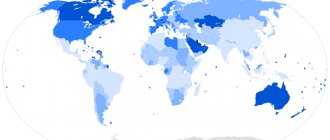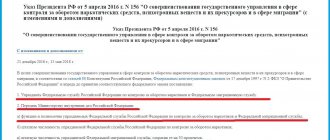Who will we count?
When asking the question of how many migrants there are in Russia, we need to clarify an important point: who exactly are we calling that? The fact is that in the Russian legal system there is no clear definition of this concept. The Constitution of the Russian Federation uses exclusively the terms “foreign citizen” and “stateless person”. However, in the media, in the legal and bureaucratic spheres, it is the word “migrant” that most often appears to designate foreign workers who have been in Russia for a long time.
Where did this interpretation come from and why are they not called migrants, for example, Indian students studying at Russian universities or Italians sent on long-term business trips?
The answer probably lies in the text of the international “Agreement on Cooperation in the Field of Labor Migration and Social Protection of Migrant Workers,” adopted by the CIS countries in 1994. It clearly states the definition:
Migrant worker is a person permanently residing in the territory of the Party of departure who is legally engaged in paid activities in the Party of employment.
It turns out that it is legally correct to call migrants the citizens of the CIS who come to the Russian Federation for the purpose of employment and long-term residence.
An agreement has been concluded between the CIS countries on the protection of migrant workers working in the territory of the Commonwealth.
Why migrants stopped flocking to Russia
Every year fewer and fewer migrants come to Russia. The number of so-called long-term international migrants to Russia has not grown since the crisis year of 2014, and their “departure” is increasing, RANEPA experts have found out.
Thus, migration population growth in 2021 turned out to be the lowest in recent years.
“Since 2014, the number of international migrants arriving in Russia has stabilized at 565–600 thousand people, but the number of those leaving has increased from 308 thousand in 2014 to 441 thousand in 2018,”
- says the latest issue of RANEPA monitoring.
As a result, the migration population growth amounted to 124.9 thousand people in 2021. This is the lowest figure according to current migration records, which have been kept since 2004.
Growth due to left statistics
According to experts, in the early 2000s, long-term migration was not fully taken into account. For this reason, the data on migration growth had to be adjusted based on the results of the All-Russian Population Census of 2010.
If we take them into account, the migration growth of the Russian population in 2021 was the lowest in the entire post-Soviet period. That is, since 1991.
A sharp increase in the number of arrivals to Russia occurred in 2011. The increase in the number of migrants was caused by a change in statistical methods. The fact is that persons registered not only at their place of residence, but also at their place of stay for a period of 9 months or more, began to be taken into account as long-term migrants.
As those registered at their place of stay ended, the number of those leaving began to grow.
At the same time, since 2021, the number of arrivals to Russia from Ukraine has decreased. In 2021, the flow of Ukrainian migrants was almost 30% less than in 2015, and the number of those leaving increased by 2.6 times.
The year of great change
According to experts, 2021 has become a turning point for migrants. He showed that at present, the decline in migration growth rates is no longer due only to accounting methods, but to economic factors.
“The potential for migration to Russia from many post-Soviet countries is close to exhaustion, especially in the countries of the western part of the former USSR,” the monitoring says.
There are fewer and fewer people migrating to Russia for a number of reasons. Firstly, everyone who wanted to leave for Russia after the collapse of the USSR has already left. That is, they began to live in the new Russia.
“The number of Russians and representatives of the titular peoples of Russia living outside Russia has greatly decreased due to repatriation to their historical homeland. The rest have largely integrated,” experts say.
Secondly, migrants began to leave Russia because the standard of living in their countries began to rise, while in Russia it began to decline. the exchange rate played a significant role in this
ruble
“There is no longer such a big difference in socio-economic development between many countries and Russia, even compared to the 2000s. This makes the choice of migration in favor of Russia not so clear,” notes RANEPA.
According to experts, citizens of an increasing number of countries of the former USSR are reorienting towards migration to the EU and other countries.
All hope is for migrants
Meanwhile, the number of Russian regions where migration decline is observed is growing.
“The smaller the population growth in Russia as a whole due to international migration, the fewer regions maintain growth. In 2021, out of 85 regions of Russia, 18 regions had an increase in migration, in 2021 – 26, in 2021 – 35 regions,” says the RANEPA review.
Migration statistics are also directly related to the renewed natural population decline in Russia. In 2021, migration was no longer able to compensate for this loss. Migration growth only compensated for the natural decline by 57.2%, which increased for the first time in the last 10 years and amounted to 99.7 thousand people.
The potential for growth in temporary migration from the countries of the EAEU (Eurasian Economic Union) is also practically exhausted.
The number of temporary migrants staying in Russia during the year has fluctuated between 9.2 and 10.2 million people over the past three years. In 2013–2014, the figures were mainly in the range of 10–11.5 million.
At the beginning of 2021, there is also no increase in the flow of migrants.
Thus, as of April 1, 2021, there were 9.56 million foreigners in the Russian Federation.
At the same time, temporary migration is still overwhelmingly migration from CIS countries: as of April 1, there were 8.2 million citizens from these countries in Russia (86% of all arrivals). The countries of Central Asia and Ukraine retain their leading positions.
The experience of the last 25 years shows that immigration has become a serious demographic resource for our country. If Russia's population is now growing, it is almost exclusively due to immigration. And even when the population was declining (in 1993-2008), immigration compensated for its natural decline by 60%.
Over the years, the population of Russia has decreased by 5.2 million people, but if there had been no immigration, the decrease would have been 13.2 million.
In total for 1992-2015. The migration increase in Russia's population amounted to about 9 million people. The role of immigration as the main source of population growth in Russia will continue in the future, and the scale of the migration influx should be quite large.
Just to cover the inevitable natural population decline and avoid a decline in Russia’s population, it may be necessary to accept 500 thousand migrants a year, or even more.
According to Anatoly Vishnevsky, director of the Institute of Demography at the Higher School of Economics, the negative trend may continue until 2035. And migrants will no longer be able to compensate for the natural population decline in Russia.
“The problem is that the birth rate is declining. And it is declining due to the fact that a smaller generation of women of childbearing age, born in the 90s of the last century, has now entered into life,” says Vishnevsky.
The second negative factor is the increase in the number of deaths of the post-war generation of the 50s. According to the optimistic scenario of the Institute of Demography, natural decline can reach 400 thousand people; according to the pessimistic scenario, it will even reach a million people a year.
Previously, the Ministry of Economic Development predicted that due to the difficult demographic situation, the country will lose approximately 800 thousand people of working age annually in the next five to six years.
How many migrants live in Russia: figures by year and country
4,546,978 foreign citizens and stateless persons were registered with migration However, as we all know, all foreigners arriving in the Russian Federation are registered with the migration authorities. This figure includes tourists, business travelers, and those arriving for treatment. We want to find out how many migrants there are in Russia.
Let's look at the number of patents issued. During the period January - May 2021, Russia issued 585,018 work patents. In 2021, this figure was much higher - 841,929. Approximately the same number was issued in 2021 - 814,576 patents. However, given the closure of the borders of the Russian Federation from March 30, 2021, it turns out that in April and May there was no one to issue new patents. Of all residents of the CIS countries, these documents are needed by citizens of Azerbaijan, Uzbekistan, Turkmenistan, Ukraine, Moldova and Tajikistan. Holders of Kazakh, Belarusian, Armenian and Kyrgyz passports do without patents or work permits, so they can be excluded from the total figure.
- Migrants in Russia
Putin’s new Decree for migrants: residence permits, temporary residence permits, registrations were “frozen” until September 15, and work without a patent was prohibited
- Elena Voropaeva
- 15.06.2020
During the period of self-isolation, the Russian Ministry of Internal Affairs automatically extended for 93 days patents that expired between March 15 and June 15. Foreign citizens who did not have a patent could work without one during this period. From June 15, a patent becomes mandatory again. True, they won’t look at the entry date when registering it yet. If we talk about the temporary residence permits received, then in the first 5 months of 2021, 60,413 were issued. The number of temporary residence permits issued was 103,023. Last year, these numbers looked like 98,221 and 77,755, respectively. It may be noted that the issuance of residence permits has become larger in scale in 2021, despite the pandemic. Below is a comparison table by year:
| January – May 2016 | January – May 2017 | January – May 2018 | January – May 2019 | January – May 2020 | |
| Patents | 674 303 | 742 013 | 814 576 | 841 929 | 585 018 |
| RVP | 136 299 | 112 615 | 107 080 | 98 221 | 60 413 |
| Residence permit | 77 199 | 78 408 | 75 677 | 77 755 | 103 023 |
| Citizenship | 113 407 | 100 278 | 104 163 | 108 577 | 255 986 |
Number of documents issued according to the Ministry of Internal Affairs of the Russian Federation.
It is easy to see how much the issuance of residence permits has increased. This is likely a consequence of laws adopted at the end of 2021 that simplify obtaining a residence permit for certain categories of citizens. The decrease in the number of temporary residence permits issued can also be partly explained by innovations that canceled this stage for some foreigners. Read more about obtaining a residence permit without a temporary residence permit.
Since the consideration of applications for temporary residence permits, temporary residence permits and citizenship takes place over several months, the data in the table reflects more of the situation before the pandemic. That is, in January-May, those who submitted documents in September 2021 - January 2021 received answers, and in the case of citizenship even earlier. But the consequences of the pandemic will be reflected in statistics starting in August 2021.
According to Rosstat data for 2021, citizens of Ukraine most often travel to the Russian Federation (161,351 people). In second place is Tajikistan (89,553), in third place is Kazakhstan (86,311). Next in descending order are: Armenia (71,984), Uzbekistan (60,796), Kyrgyzstan (53,810), Azerbaijan (34,619) and Moldova (26,513).
However, even in official sources the information presented may not coincide. Last year, the media actively circulated information that the FSB border service had released information on the number of labor migrants, citing the figure as 2.4 million people. However, it is difficult to say whether these data can be considered objective, because this service counts the number of foreigners entering and leaving. So, if an employee often travels across the border, he will be counted several times.
Bureaucratic difficulties in counting do not allow us to name truly objective figures, photo: rus.azattyq.org
Subscribe to Migranta Rus: Yandex News.










